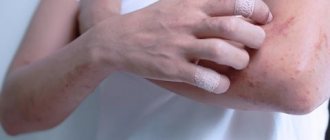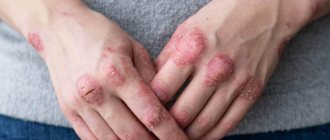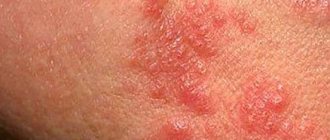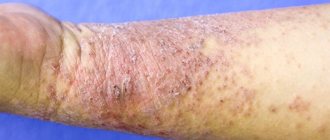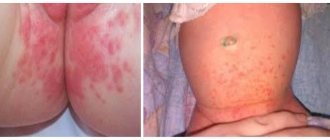- Symptoms of dyshidrosis
- Types of disease
- Complications of dyshidrosis
- Causes of crowberry
- Disease in children and pregnant women
- Diagnostics
- Treatment
- Drugs for the treatment of dyshidrosis
- Hardware procedures
- Diet for crowberry
- Duration of treatment and prevention of the disease
Dyshidrosis is a dermatological disease, otherwise called pompholyx or dropsy. The disease affects the sweat glands.
The main symptom is small blisters filled with fluid. They appear on the skin of the palms and legs and are accompanied by itching. After two or three days, dry crusts form in place of the blisters. As a rule, the disease manifests itself in the off-season.
Dyshidrosis in many cases is a type of allergy or occurs due to an imbalance in the functioning of the nervous system. This disease cannot be transmitted from the patient to other people.
Symptoms of dyshidrosis
The most important sign of dyshidrosis is damage to the skin of the feet and hands. If changes appear in other parts of the body, this means that the patient does not have water, but another dermatological disease.
The main signs of dyshidrosis:
- redness;
- swelling;
- bubbles filled with liquid;
- itching;
- peeling and sloughing of the affected skin.
When you touch the affected area, you may feel that the skin has become hotter.
Possible complications
When scratching or opening the rash on your own, there is a high risk of pathogenic microorganisms getting inside. This leads to an inflammatory process: the blisters turn into pustules. The liquid inside them loses its transparency, acquiring a yellowish color. The discomfort intensifies, severe swelling appears. In some cases, the patient experiences an increase in body temperature.
Other complications of hand dyshidrosis include panaritium and lymphangitis: purulent inflammation of the finger and lymphatic vessel, respectively. In the latter case, a painful cord forms under the skin.
Types of disease
There are three types of dyshidrosis, which differ in manifestation and severity:
- True dyshidrosis. At the initial stage, the disease manifests itself as redness, swelling and swelling of the skin. Then bubbles appear on it, the dimensions of which are about a millimeter and do not change in the future. True crowberry affects the skin of the palms. The foci of the disease are located at the base of the fingers. After 7-10 days, the blisters begin to open, which is accompanied by severe itching and burning. If the patient scratches the affected areas of the skin, this can lead to inflammation caused by infection in the wound.
- Dyshidrotic eczema. This is the most severe type, which if left untreated becomes a chronic disease. With eczema, fluid-filled blisters form on the palms and legs and increase in size. After some time, the bubbles open and dry out. The disease develops rapidly and causes a deterioration in overall health. The patient develops a headache, fever, and enlarged lymph nodes. With dyshidrotic eczema in children, appetite decreases and the child becomes lethargic. The disease most often develops with a hereditary predisposition or after severe stress.
- Dry lamellar pompholyx. The peculiarity of the disease is the absence of bubbles. Instead, the skin begins to itch slightly and areas of peeling appear. When itching, the skin can peel off in thin sheets, hence the name of the disease. It is important to know that with dry lamellar dyshidrosis, the skin should not be scratched, as this leads to inflammation and aggravation of the symptoms of the disease.
The disease develops mainly in residents of countries with a humid tropical or very dry climate, and tourists who prefer exotic holidays.
Material and methods
We observed 47 patients (17 men and 30 women) with dyshidrotic manifestations on the skin of the palms and soles. All patients were divided into two groups.
Group 1 consisted of 27 patients with a dyshidrotic form of mycosis of the skin of the feet; There were no hand lesions in this group.
2nd - 20 patients with DE of the palms and soles. Lesions of the soles only were diagnosed in 13 patients, palmoplantar process - in 7; There were no isolated lesions of the hands.
Criteria for inclusion in group 1: vesicular process on the skin of the soles without weeping; detection of mycelium of pathogenic fungi in lesions, the presence of onychomycosis.
Criteria for inclusion in group 2: an established diagnosis of chronic eczema, for which the patient has been observed by a dermatologist for at least 2 years, the presence of seasonality in exacerbations of the skin process, and an undulating course.
Exclusion criteria from group 2: detection of mycelium of pathogenic fungi in the lesions, presence of onychomycosis; the presence of an acute process with weeping.
All patients of group 1 were treated in accordance with clinical recommendations for the management of patients with mycosis of the skin of the feet: systemic therapy consisted of prescribing terbinafine 250 mg orally once a day for at least 16 days; Cetirizine 10 mg once a day for 20 days.
All patients of group 2 were prescribed treatment in accordance with clinical recommendations for the management of patients with chronic eczema: systemic therapy - cetirizine 1 tablet once a day for a course of 20 days; injections of dexamethasone solution 1 ml (4 mg) daily, no more than 5 injections per course.
External treatment for all patients in both groups was carried out according to a similar program: on days 1 and 2, combined corticosteroid + antibiotic aerosols were prescribed to achieve a drying and anti-inflammatory effect; from the 3rd day, patients of both groups were prescribed Tetraderm
, which was applied to the rash areas 3 times a day. In order to obtain a minimal occlusive effect and prevent the development of maceration, the area of application of the cream was covered with gauze or paper napkin in one layer. The bandage was kept on the affected area for at least 2 hours.
The results of treatment were assessed by the dynamics of the following clinical symptoms: itching, dynamics of rashes, the presence of secondary elements (peeling, cracks), and the presence of side effects.
Causes of crowberry
Previously it was believed that the pathology develops when the ducts of the sweat glands become clogged, but at the moment this theory is completely refuted. Most often, the development of the disease is caused by a violation of the innervation of the sweat glands of the skin. This occurs due to a specific reaction of the nervous system to severe stress. In general, experts distinguish several common causes of pathology:
- hereditary predisposition;
- decreased immunity;
- endocrine disorders;
- dermatological diseases (fungi and infectious skin lesions, pyoderma);
- predisposition to allergies;
- diseases of the gastrointestinal tract;
- vegetative-vascular dystonia, other disorders of the nervous system;
- interaction with aggressive chemicals;
- psycho-emotional overload, mental fatigue;
- psychological trauma, severe stress;
- long-term use of antibiotics.
Disease in children and pregnant women
Not only adults, but also children are susceptible to the disease. In infancy, dropsy can occur due to breastfeeding if the child's mother does not eat properly. Breastfeeding women should not consume foods that may cause allergic reactions.
At an older age, dropsy in children occurs due to a hereditary predisposition or against the background of neuropsychic overload. The cause of the pathology can also be a disruption in the functioning of the immune system. During pregnancy, the risk of developing dyshidrosis increases, since in this condition the load on the female body increases. This leads to certain reactions from the nervous system. You should know that it is prohibited to use certain drugs to treat crow's feet in children and pregnant women, as they can cause unwanted side effects.
What is the disease?
Dyshidrosis is a skin disease of the hands and feet that affects the sweat glands.
Other names: pompholyx, crowberry.
Dyshidrosis manifests itself as itchy rashes in the form of groups of small watery blisters. The disease is of an allergic nature and often occurs against the background of other skin diseases.
There is seasonality: symptoms of dyshidrosis are more often observed in spring and autumn.
Important:
Dyshidrosis is not transmitted from person to person.
Diagnostics
At the first signs of the disease, you should consult a dermatologist. The patient may also need to consult a gastroenterologist, allergist, or immunologist. The symptoms of the disease are similar to fungal infections and psoriasis, so a whole range of diagnostic procedures are prescribed. It includes:
- fungal analysis;
- allergy test;
- endoscopic examination;
- immunogram.
Thanks to differential diagnosis, the doctor will determine the exact nature of the disease and choose a treatment regimen.
results
Pronounced positive dynamics of the skin process was obtained in all patients of both groups. In patients of group 1, itching decreased significantly by the 4th day of treatment and completely resolved by the 8-10th day. Fresh vesicular rashes also stopped appearing by the 10th day of therapy. However, 7 (25.9%) patients required additional administration of aniline dyes in order to prevent secondary infection of small cracks that form at the site of resolved vesicles. Complete resolution of the skin process was observed by the 20th day of treatment.
In patients of group 2, the vesicular process was generally characterized by a more persistent course, and itching continued to bother patients until the 10-12th day from the start of treatment. However, the disappearance of itching was more abrupt than in patients of group 1, and practically coincided with the moment the appearance of vesicles ceased; this phenomenon occurred on the 12-14th day from the start of treatment. Vesicular lesions of the hands and feet in 7 patients in this group began to regress simultaneously. Only 3 patients required aniline dyes. Complete resolution of the skin process was not obtained in all patients: out of 20 patients, 4 (20%) had erythematous-squamous lesions in the absence of vesiculation by the 20th day of treatment.
During observation, there were no adverse events in both groups.
Drugs for the treatment of dyshidrosis
Treatment of the disease includes medications for external use and oral administration. To reduce symptoms, affected areas of the skin are treated with antiseptics based on boric acid, chlorhexidine and other disinfecting compounds. To reduce swelling and redness, use zinc and salicylic ointment and other anti-inflammatory drugs.
Antihistamines are prescribed for oral administration, which relieve allergy symptoms. The patient is also prescribed sedatives, which reduce the sensitivity of the nervous system to psycho-emotional stress. To improve the functioning of the immune system, immunostimulants are used. In severe forms of the disease, glucocorticosteroids are indicated.
Discussion
Tetraderm cream
is a combination drug of the following composition: mometasone furoate 0.05%, gentamicin sulfate 0.1%, econazole nitrate 1%, dexpanthenol 5%.
The light creamy texture of the drug is achieved using a unique ratio of excipients included in the pharmaceutical base: 1 g of the drug contains liquid paraffin 120 mg, cetostearyl alcohol 70 mg, propylene glycol 50 mg, macrogol 6 cetostearyl ether 20 mg, macrogol 25 cetostearyl ether 20 mg , sodium dihydrogen phosphate dihydrate 2 mg, purified water to 1 g [17].
This drug, when applied to the skin, provides a pronounced anti-inflammatory, antimicrobial, antifungal effect, and also stimulates reparative processes in the skin [17].
Diet for crowberry
Patients with dyshidrosis caused by food allergies need to review their diet and exclude foods that increase the manifestations of an allergic reaction. Such products include:
- dishes high in salt, spices, herbs;
- honey;
- citrus fruits, berries, bananas, melon;
- nuts;
- Fish and seafood;
- chocolate, cocoa, coffee;
- alcoholic drinks;
- eggs;
- foods high in sugar, baked goods.
When treating dyshidrosis, it is worth focusing on fermented milk products, cereals, fresh and boiled vegetables. The diet of a patient with chronic dyshidrosis should contain enough foods high in iron and phosphorus.
Prevention
Prevention of the disease is based on:
- dietary nutrition, in which it is necessary to limit as much as possible the consumption of salty, fried, canned, alcohol, food allergens, coffee;
- avoiding direct contact with irritating substances and household and industrial allergens;
- wearing clothes and underwear only from natural fabrics;
- careful control of body hygiene, timely treatment of all infectious diseases, elimination of foci of skin inflammation, antiseptic treatment of any skin injuries;
- preventive consultations with a dermatologist, regular examinations and preventive courses of treatment for eczema.

